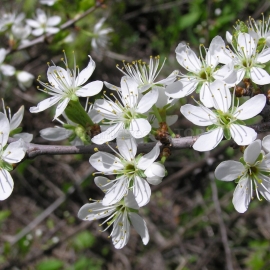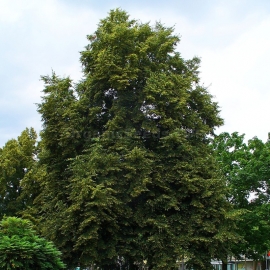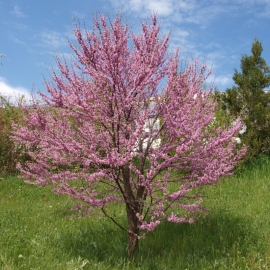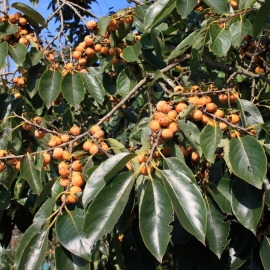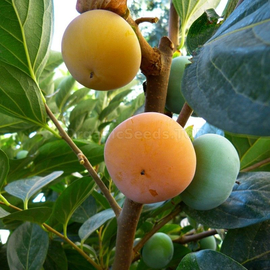







Organic Oriental persimmon Seeds (Diospyros kaki)
3.00 €
The tree reaches a height of up to 10 meters, the plant looks like an apple tree, in the fall it turns red, the under is a brownish-yellow, fleshy berry the size of an apple, edible, sweet, orange, similar to a tomato.
-
Oriental persimmon Chinese persimmon, Japanese persimmon or kaki persimmon / Diospyros kaki
Is a tree that reaches a height of up to 10 meters (there are known cases of reaching a height of 12 m). In appearance, the plant looks like an apple tree. The name may be pronounced like Japanese persimmon. The leaves are alternate, ovate-oblong, dark green, pale below, broadly lanceolate. In autumn they turn red.
Flowers in the leaf axils are single or several, on short stalks. The calyx is 4-lobed. The corolla is 4-lobed, bell-shaped, dark red. Male flowers have 16 stamens; in females there are 4-8 staminodes and a superior ovary, usually 8-locular, with 1 ovule in each nest.
Eastern persimmon blooms from May to June. The yellowish-white flowers can be of three types: male, female and mixed. The plants are usually monoecious with male and female flowers separately on the same tree, but dioecious crops also exist. Pollination is carried out by insects. If the female flowers are not fertilized, they reproduce by parthenogenesis and then produce seedless fruit.
The fruit is a brownish-yellow, fleshy berry the size of an apple, edible, sweet, orange, and tomato-like. The spherical or oval fruit weighs up to 500 grams. The smooth, shiny and thin skin ranges in color from yellow to red-orange. The somewhat lighter flesh of the fruit can contain up to 8 seeds and has an astringent taste. When ripe, the fruit becomes softer, comparable to kiwi.
The fruits of the eastern persimmon become ripe when most of the leaves have already fallen off, in October-November. The ripening period occurs in some varieties at the beginning, in others - at the end of October.
The high tannin content in unripe oriental persimmon fruits causes a bitter, astringent taste, which disappears along with the tannins when ripe and exposed to frost. The very high content of beta-carotene (provitamin A) makes them especially valuable.
Ripe fruits contain glucose (up to 20%) and are rich in vitamin C, minerals, fiber and phenols, making them very useful in preventing cardiovascular diseases. They are used fresh. The fruits must be fully ripe and even overripe. The fruit can also be dried like a fig and can be used to make jam and desserts. Energy value - 70 kcal per 100 grams of product.
Usually persimmons are eaten as a self-sufficient fruit. Persimmon pulp is used in baked goods, jellies, puddings, mousses, marmalades and jams. Dried persimmons are popular, and persimmons are also used to make molasses, cider, beer and wine. Unripe astringent persimmons are used in Japan to make sake. Roasted seeds can be used as a coffee substitute.
Persimmons contain 2 times more dietary fiber and beneficial microelements than apples. It also contains a lot of antioxidants. Persimmon fruits contain large amounts of water, ash, proteins, carbohydrates, organic acids and tannins. This fruit is also rich in potassium, calcium, magnesium, phosphorus and iron, as well as vitamins A, C and P.
Persimmon is a dietary product indicated for indigestion due to the presence of pectin. It is used in folk medicine for stomach diseases. The high sugar content, mainly glucose and fructose, supports cardiovascular health without peaking blood glucose levels.
The magnesium contained in persimmons reduces the likelihood of kidney stones. Persimmon has a diuretic effect and tonic properties. It has a bactericidal effect against Escherichia coli, hay bacilli, and Staphylococcus aureus
With this product buy
Product code: 3057
2.00 €
A small thorny shrub from the genus Plum, 3.5-4.5 m high, less often a low-growing tree no higher than 8 m, growing, forms dense thorny and impassable thickets, edible fruits similar to a plum, up to 12 mm in diameter.
Product code: 12447
1.14 €
The tree is up to 25 (30) m high, the bark is dark gray, lamellar exfoliating in old trees, sometimes to a greater extent with deep grooves. the bark of young twigs is glabrous, brown-reddish, the shoots are at first with silky white pubescence, which soo
Product code: 13301
3.00 €
A highly branched tree or shrub with a wide crown, with reddish branches and heart-shaped, green leaves, at the time of flowering, completely refute the specific name of extraordinary bright beauty.
Product code: 15018
3.00 €
The tree is 15-20 meters high, berry-like with juicy flesh, yellow when grown, 1-2 cm in diameter, edible and contains a lot of sugars, malic acid and vitamins, found in food fresh, caught by frost, often dried.

